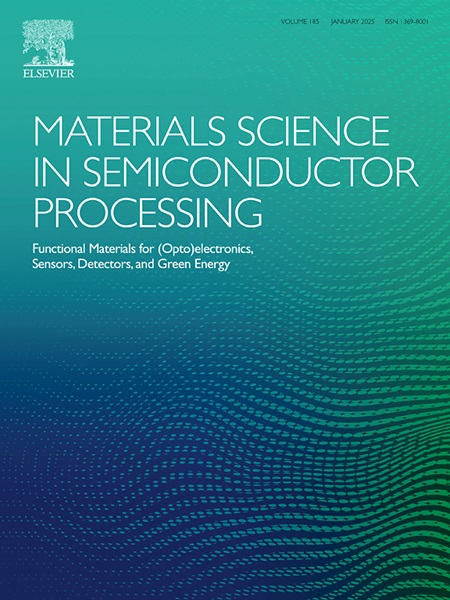Gaussian distribution on electrical properties of identically fabricated Au/n-GaN Schottky junctions with a Nd2O3 interfacial layer
IF 4.2
3区 工程技术
Q2 ENGINEERING, ELECTRICAL & ELECTRONIC
引用次数: 0
Abstract
This work emphasizes the twenty Au/Nd2O3/n-GaN MIS junctions identically fabricated using the e-beam evaporation technique. The electrical and interfacial properties of the identically prepared MIS junctions were investigated using current-voltage (I-V) measurements. The surface topology and chemical properties of the Nd2O3 film on the n-GaN were investigated using AFM and XPS techniques. The barrier height (Φb) and the ideality factor (n) of the twenty MIS junctions were estimated, revealing variability across different junctions. Using statistical analysis, the mean values of rectification ratio (RR), barrier height (Φb), ideality factor (n), series resistance (RS) and shunt resistance (RSh) were estimated from I-V data based on thermionic emission (TE) theory. The fluctuations in the electrical parameters are attributed to an inhomogeneous interfacial layer and barrier height, as well as the non-uniformity of interfacial traps, dislocations and grain boundaries. The laterally homogeneous Φb was also estimated for the twenty MIS junctions from the linear association between the experimental n and Φb. The lateral inhomogeneity of Φb was clarified by examining the correlation between n and Φb of the identically prepared MIS junctions. Further, the mean interface state density (NSS) was determined for the MIS junctions.

具有Nd2O3界面层的Au/n-GaN Schottky结电学性质的高斯分布
本文重点研究了采用电子束蒸发技术制备的20个Au/Nd2O3/n-GaN MIS结。利用电流-电压(I-V)测量研究了相同制备的MIS结的电学和界面特性。利用原子力显微镜(AFM)和XPS技术研究了n-GaN上Nd2O3薄膜的表面拓扑结构和化学性质。估计了20个MIS连接的屏障高度(Φb)和理想因子(n),揭示了不同连接之间的可变性。采用统计分析方法,基于热离子发射(TE)理论,从I-V数据中估计整流比(RR)、势垒高度(Φb)、理想因数(n)、串联电阻(RS)和分流电阻(RSh)的平均值。电学参数的波动归因于界面层和势垒高度的不均匀性,以及界面陷阱、位错和晶界的不均匀性。从实验n和Φb之间的线性关联中,还估计了20个MIS连接的横向均匀Φb。通过检查相同制备的MIS连接的n和Φb之间的相关性,澄清了Φb的横向不均匀性。进一步测定了MIS连接的平均界面态密度(NSS)。
本文章由计算机程序翻译,如有差异,请以英文原文为准。
求助全文
约1分钟内获得全文
求助全文
来源期刊

Materials Science in Semiconductor Processing
工程技术-材料科学:综合
CiteScore
8.00
自引率
4.90%
发文量
780
审稿时长
42 days
期刊介绍:
Materials Science in Semiconductor Processing provides a unique forum for the discussion of novel processing, applications and theoretical studies of functional materials and devices for (opto)electronics, sensors, detectors, biotechnology and green energy.
Each issue will aim to provide a snapshot of current insights, new achievements, breakthroughs and future trends in such diverse fields as microelectronics, energy conversion and storage, communications, biotechnology, (photo)catalysis, nano- and thin-film technology, hybrid and composite materials, chemical processing, vapor-phase deposition, device fabrication, and modelling, which are the backbone of advanced semiconductor processing and applications.
Coverage will include: advanced lithography for submicron devices; etching and related topics; ion implantation; damage evolution and related issues; plasma and thermal CVD; rapid thermal processing; advanced metallization and interconnect schemes; thin dielectric layers, oxidation; sol-gel processing; chemical bath and (electro)chemical deposition; compound semiconductor processing; new non-oxide materials and their applications; (macro)molecular and hybrid materials; molecular dynamics, ab-initio methods, Monte Carlo, etc.; new materials and processes for discrete and integrated circuits; magnetic materials and spintronics; heterostructures and quantum devices; engineering of the electrical and optical properties of semiconductors; crystal growth mechanisms; reliability, defect density, intrinsic impurities and defects.
 求助内容:
求助内容: 应助结果提醒方式:
应助结果提醒方式:


